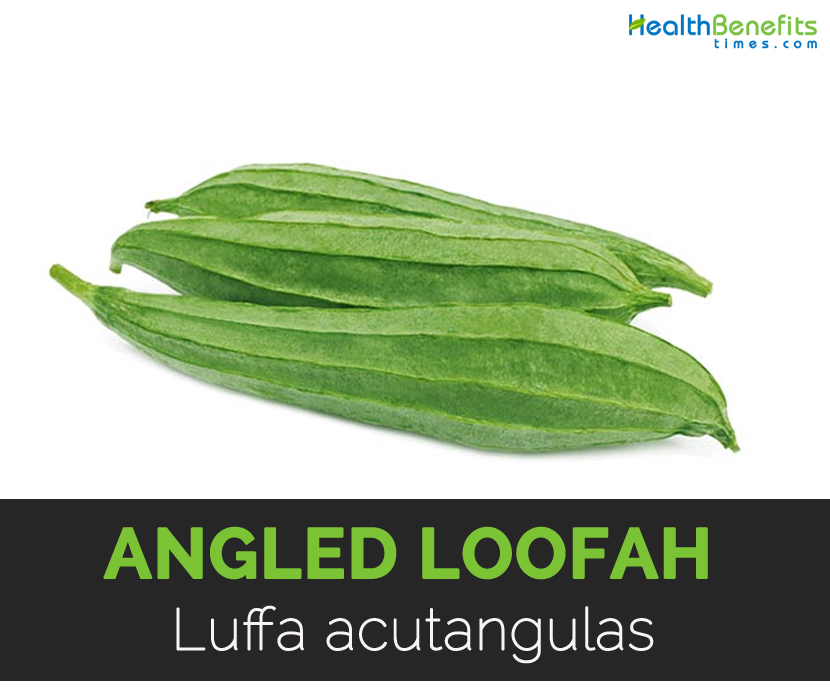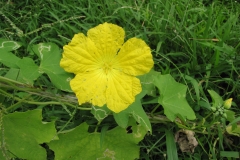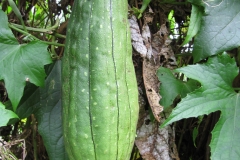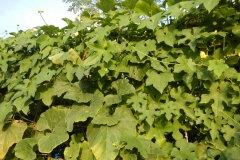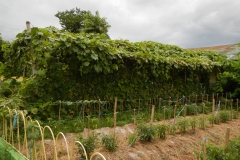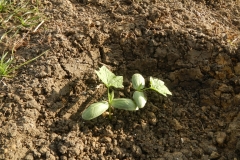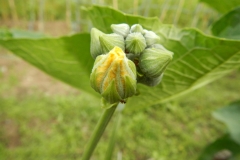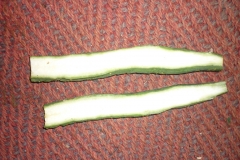| Angled Loofah Quick Facts | |
|---|---|
| Name: | Angled Loofah |
| Scientific Name: | Luffa acutangulas |
| Colors | Green |
| Shapes | Clavate-oblong, 15-30 cm long |
| Name | Angled Loofah |
|---|---|
| Scientific Name | Luffa acutangulas |
| Common/English Name | Angled Loofah, California Okra, Angled Luffa, Chinese Okra, Ribbed Loofah, Ribbed Gourd, Ribbed Gourd, Ridged Luffa, Ridged Gourd, Silk Gourd, Silk Squash, Silky Gourd, Sinqua Melon, Strainer Vine, Sinkwa Towelsponge, Vegetable Sponge |
| Name in Other Languages | Arabic: Bamya Seeny; Bangladesh: Jhinga; Brazil: Bucha-Pepino, Bucha De Purga, Maxixe-Do-Pará (Portuguese); Burmese: Bju: Da, Byú Dá; Chinese: Leng SSu Kua, Leng Si Gua, Yueh Ssu Gua, Yue Si Gua, Si Gua, Ssu Kua; Czech: Lufa Ostrohranná; Danish: Kantlufa, Kantagurk, Singkwa-Melon; French: Papngaye, Concombre Papengaie, Eponge Vegetale Torcho; German: Luffa; India: Jhinga, Jika (Assamese), Jhinga, Sataputi, Jinga, Titotorai, Titojhinga, Titodhundul (Bengali), Gudari, Jinga, Jhimani, Kali Tori, Karvi Tori, Karviturai, Karvi-Tori, Sataputitorai, Torai, Turi, Tori, Turai, (Hindu), Eere Kaayi, Heere Kaayi Balli, Heere Balli, Heere-Kai, Hire Balli, Hirekayi, Hire Kaayi, Kadupadagila, Kahi heere, Kahire, Kahiheere Balli, Naaga daali balli (Kannada), Djinji, Cheru-Peeram, Peechhakam, Piccil, Piccinna, Puichenggah, Picinna, Puttalpiram (Malayalam), Mayang-Shebot (Manipuri), Dodaki, Dodke, Dodka, Ghosavala Shiralla, Gomsali, Shirola, Sataputi, Turai (Marathi), Toorai, Ghosala Kunduru, Tooria (Oriya), Dhamargava, Dhamargavah, Dharaphala, Dhamargowa, Ghantali, Dirghaphala, Ghosa, Jalini, Gramya, Jhingaka, Karkotaki, Karkashachhada, Katukoshataki, Kesataki, Kausataki, Kosataki, Krishna, Koshataki, Kritachhidra, Kritawedhana, Kritavedhana, Krtavedhana, Krtavedhanah, Ksvedah, Kshveda, Laghukoshataki, Mrdangaphala, Mridangaphalika, Mrdangaphalam, Pitapushpa, Rajakosataki, Rajakoshataki, Saptaputri, Rajimatphala, Sukosha, Supushpa Sushodhani, Sutikta, Svaduphala,Svadukosataki, Tiktakoshataki, Tikta, Turai (Sankrit), Atalai, Atalankay, Atalakkay, Cakati, Cakaram, Cakkarakkoti, Calini, Cakkaram, Canikappurikkoti, Canikappuri, Canikkappuri, Catinikkoti, Catini, Cattiyam, Cittirakunam, Cinkakam, Curiyanaiyariyappanni, Itukalam, Itukal, Itukalikkoti, Itukali, Kalalapu, Kecattiyam, Kalapu, Kiritaveni, Kirutacittiram, Kirukampali, Kiruttuvetan, Kirutukakkoti, Kirutuvetan, Kirutukam, Kirutuvetanan, Kocamam, Kocarppam, Kocari, Kocavati, Kolakakkoti, Koccam, Kolakam2, Kolunkirikkoti, Kolunkiri, Kosam2, Macukam, Kovaritaki1, Makacalini, Maruvarikam, Malinavalli, Maruvarikkoti, Mirutankapalam, Nacukatitakkoti, Nacukam, Nacukatitam, Narpikkankoti, Nilappirkku, Narpirkku, Patarkay, Pampikai, Patarkoti, Patarkaykkoti, Peerkankaai, Peerakai, Pekankai, Peerkku, Peyppichukku, Peyppirkku, Peyppirkam, Pikunkai, Pikangai, Pirkkangai, Pirkkil, Pirkku, Picukku, Pikumkai, Pirankoti, Pir, Pirkkakkoti, Pirkkankoti, Pirkkankay, Pitaputpi, Tamarakkavam, Racakakkoti, Racakam, Tamarkkatavakkoti, Tamarkkatam, Tamarkkavakkoti, Tamarkkavam, Tamarkkavam, Tinpirkku, Tikkay, Varippirkku, Velakam, Velakakkoti, Velam (Tamil), Beera, Beerakaaya, Birakaya, Beerakaya, B Burkaai, Urkai (Telugu), Bhol (Urdu); Indonesia: Oyong, Petola (Malay), Langker Batang, Langker, Langker Ghaltek (Madurese), Kimput, Oyong (Sundanese), Jeme, Gambas, Kajur, Oyong, (Javanese); Japanese: Hechima, Shokuyou Hechima, Togado Hechima; Khmer: Ronôông Chrung, plai no-nong (ផ្លែននោង); Laotian: Mai Loi, Looy; Malaysia: Ketola, Petola Segi, Petola, Petola Sanding; Madascagar: Papengaye, Lian Torchon Des Antilles, Papangay (French); Mauritius: Papengaye, Courge Anguleuse De Chine, Papangay (French); Myanmar: pwet thee; Nepal: Pate Ghirola, Pate Toriya; Persian: Khiyar; Philippines: Patula Baibing (Sulu), Buyo-Buyo, Saykua (Bisaya), Patola, Kabtiti, Cabatiti, Patolang, Patola (Tagalog); Polish: Trukwa Ostrokątna; Portuguese: Gousalim, Bucha De Purge, Lufa Riscada; Singapore: Sin-Kwa (Cantonese), Kak Kuey (Hokkien); Spanish: Calabaza De Aristas, Dringi; Sri Lanka: Dara Veta Kola, Vata Kolu, Veta Kola, Wetakolu (Sinhalese); Taiwan: Si Gua; Thai: Buap-Liam, Buap, Manoi-Liam; Tibetan: Ko Sa Ta Ki, Ko-Sa-Ta-Ki; Vietnam: Skoo Ah (Hmong); Mướp Khía, Mướp Tau |
| Plant Growth Habit | Large monoeious annual climber |
| Leaf | 15-20 cm long |
| Flower | Yellow, 4–5 cm across |
| Fruit shape & size | Clavate-oblong, 15-30 cm long |
Plant description
Angled Loofah is a vigorous climbing, monoecious, coarse and annual herb with branched, 3 fid tendrils and slender pentagonal, furrowed, densely hairy and green stem. Stem is brownish-yellow, five angled, glabrous and 0.2-0.4 cm thick. Leaves are 25 cm long borne on short, subterete and longitudinally grooved petioles. Lamina is broad ovate in outline, scabrous and shallowly five to seven lobed. Flowers are axillary, yellow, 4-5 cm across. Male flowers form in long peduncled raceme, 15 to 20 flowered, 3 stamens within campanulate. Fruit is ellipsoid, fusiform or clavate, narrowed at base and rounded at the apex, thinly hairy, 10 ribbed, densely punctate, grayish green and 30 cm or more long. Seeds are broad ellipsoid and 1–1.2 cm by 0.7–0.8 cm. Roots are yellowish-brown and almost cylindrical.
Leaf
Petiole is 3-8 cm long, brownish yellow, somewhat twisted, angular and wrinkled. Lamina is pale or light green, crumpled, broad and 6-9 cm long.
Root
Roots are cylindrical, yellowish-brown, 8- 12 cm length and 0.7 cm thickness. It is rough because of longitudinal wrinkles.
Stem
Stem is brownish- yellow in colour, 0.2-0.4 cm thick, 5 angled, glabrous, and consists of tendrils.
Flower
Male flower is light greenish-yellow occurring in small racemes having pubescent calyx and lanceolate lobes.
Fruits
Fruits are obovate, pale yellowish brown about 4-10 cm long and 2-4 cm broad.
Health Benefits of Angled Loofah
1. Weight loss
Angled Loofah has low content of saturated fat and cholesterol. High water content makes it food with low calories. It is used to treat jaundice and a very good natural remedy for jaundice. Powdered dried fruits are used for treating jaundice.
2. Skin health
The matured and dried Angled Loofah has a sponge which is used as an exfoliating product while bathing. It helps to eliminate dead cells from skin and makes the skin smooth and conditioned. Angled Loofah has blood purifying properties which is helpful for pimples and acne problems. It is effective for combating foot and body odor.
3. Lowers inflammation
Ridge gourd seeds are used as anti-inflammatory and analgesic substance. Studies have shown the antioxidant capabilities of seeds extract confirming antioxidant, analgesic and anti-inflammatory effects of extract. It has high presence of flavonoids and phenolic acid in seed extract. The seed extract provides relief from pain caused due to inflammatory disorders.
4. Antimicrobial activity
It has long been used in Ayurveda medicine in India as a treatment for various conditions including fungal, viral and bacterial infections. Some studies have shown that the fruit and plant have potential use for their antimicrobial properties. Fruit powder of the ridge gourd was macerated with methanol and ethyl acetate and antibacterial activities were observed in both the methanol extract and the ethyl acetate extract. Both extracts had an inhibiting effect on different types of bacteria including E. coli, B. subtilis, P. aeruginosa and S. aureus.
5. Purifies blood
Add Angled Loofah to the diet and it is effectively cleanses blood for pollutants. It boosts liver health and decreases side effects of alcohol intoxication.
6. Laxative properties
Angled Loofah alleviates constipation problems and used to cure piles.
7. Cure jaundice
Angled Loofah has medicinal properties that help to heal jaundice.
8. Helpful for diabetes
Angled Loofah has particular qualities which is helpful for diabetics. The presence of insulin like peptides helps to lower sugar level in both bloods along with urine. It restricts blood insulin level to reasonable quantity.
Traditional uses
- In folkloric medicine, fruit juice is used to be aperient, diuretic and demulcent.
- Juice is used for jaundice.
- Leaf decoction is used for uraemia and amenorrhoea in Java.
- Use the leaves juice as eye drop for conjunctivitis and apply it externally for sores, itch and various animal bites.
- Use the poultice leaves for enlarged spleen, leprosy and haemorrhoids in India and Bangladesh.
- Use the seed oil for dermatitis.
- In Maharashtra, the fruits powder is used as snuff to prevent jaundice.
- Apply the juice of roasted young fruit to cure headache.
- To eliminate kidney stones, add the roots of Angled Loofah to milk or water.
- Use the leaves juice as dressing in piles, ringworms, spleen inflammation and leprosy.
Ayurvedic remedies
For jaundice: Mix 1 cup of Angled Loofah juice with 2 spoons of sugar. Take it twice daily as cure jaundice.
For bleeding from wound: Apply the grounded fruit pulp on the wound to stop bleeding from the wounds.
For stomach worms: Boil 1 Angled Loofah in two glasses of water and then add salt to it. Take this mixture twice daily to kill stomach worms.
For asthma: Grind Angled Loofah to extract ½ cup Angled Loofah juice mixed with sugar. Take it twice a day to cure cancer.
Culinary uses
- In China, India, West Africa and Southeast Asia, young leaves and fruits are used as vegetables.
- Immature fruit is steamed, stirfried and grated into omelette or fritter or added to soups.
- Cut it into slices and fry it in batter.
References:
https://www.itis.gov/servlet/SingleRpt/SingleRpt?search_topic=TSN&search_value=503569#null
http://ijpsm.com/Publish/Jan2017/V2I101.pdf
https://en.wikipedia.org/wiki/Luffa_acutangula
http://nutrayou.blogspot.com/2015/10/ridge-health-benefits.html
http://www.kalashseedsonline.com/vegetable-health-tips/health-benefits-of-ridge-gourd.html


